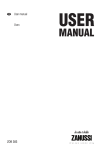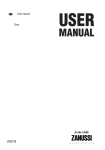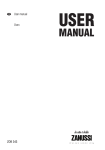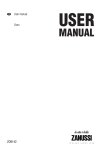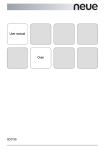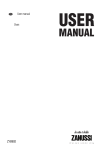Download Zanussi ZOB10501 User's Manual
Transcript
EN User manual Oven ZOB10501 Contents Safety information _ _ _ _ _ _ _ _ _ _ _ _ _ _ _ _ _ _ Product description _ _ _ _ _ _ _ _ _ _ _ _ _ _ _ _ _ Before first use _ _ _ _ _ _ _ _ _ _ _ _ _ _ _ _ _ _ _ Daily use _ _ _ _ _ _ _ _ _ _ _ _ _ _ _ _ _ _ _ _ _ _ Using the accessories _ _ _ _ _ _ _ _ _ _ _ _ _ _ _ _ Additional functions _ _ _ _ _ _ _ _ _ _ _ _ _ _ _ _ _ 2 4 4 5 5 6 Helpful hints and tips _ _ _ _ _ _ _ _ _ _ _ _ _ _ _ _ 6 Care and cleaning _ _ _ _ _ _ _ _ _ _ _ _ _ _ _ _ _ _ 9 What to do if… _ _ _ _ _ _ _ _ _ _ _ _ _ _ _ _ _ _ 11 Installation _ _ _ _ _ _ _ _ _ _ _ _ _ _ _ _ _ _ _ _ 12 Environment concerns _ _ _ _ _ _ _ _ _ _ _ _ _ _ _ 13 Subject to change without notice. Safety information Before the installation and use, read this manual carefully: • For your personal safety and the safety of your property • For the respect of the environment • For the correct operation of the appliance. Always keep these instructions with the appliance also if you move or sell it. The manufacturer is not responsible if incorrect installation or use results in damage. Children and vulnerable people safety • This appliance can be used by children aged from 8 years and above and persons with reduced physical, sensory or mental capabilities or lack of experience and knowledge if they have been given supervision or instruction concerning use of the appliance in safe way and understand the hazards involved. Children shall not play with the appliance. • Keep all packaging away from children. There is the risk of suffocation or physical injury. • WARNING: Keep children and animals away from the appliance when the door is open or the appliance is in the operation, because it becomes hot. There is the risk of injury or other permanent disability. • If the appliance has Child Lock or Key Lock (Control Lock) function, use it. It prevents children and animals from accidental operation of the appliance. General safety • Do not change the specifications of this appliance. There is the risk of injury and damage to the appliance. • Do not let the appliance stay unattended during operation. • Switch off the appliance after each use. 2 Installation • Only an approved electrician can install and connect the appliance. Contact an approved service centre. This is to prevent the risks of structural damage or physical injury. • Make sure that the appliance is not damaged because of transport. Do not connect a damaged appliance. If necessary, contact the supplier. • Remove all packaging, stickers and layers from the appliance before first use. Do not remove the rating plate. It can invalidate the guarantee. • Fully obey the laws, ordinances, directives and standards in force in the country where you use the appliance (safety regulations, recycling regulations, electrical or gas safety rules etc.). • Make sure that the appliance is disconnected from the power supply during the installation. • Be careful when you move the appliance. The appliance is heavy. Always use safety gloves. Do not pull the appliance by the handle. • The electrical installation must have an isolation device which lets you disconnect the appliance from the mains at all poles. The isolation device must have a contact opening width of minimum 3 mm. • You must have correct isolation devices: line protecting cut-outs, fuses (screw type fuses removed from the holder), earth leakage trips and contactors. • The shock protection parts must be fixed in such a way that they cannot be undone without tools. • Some parts of the appliance carry current. Close the appliance with furniture and make sure that there are no free spaces. It prevents electrical shock because you cannot accidentally touch dangerous parts. www.zanussi.com • Before the installation, make sure that the kitchen cabinet has the recess dimensions applicable. • Make sure that the appliance is installed below and adjacent safe structures. • Keep the minimum distances to the other appliances and units. • Install the appliance with its back and one side close to the higher appliance. The other side must be close to appliance with the same height. • The appliance cannot be positioned on a base. Electrical connection • The appliance must be earthed. • Make sure that the electrical data on the rating plate agree with your domestic power supply. • Information on the voltage is on the rating plate. • Always use a correctly installed shockproof socket. • When you connect electrical appliances to mains sockets, do not let cables touch or come near the hot appliance door. • Do not use multi-way plugs, connectors and extension cables. There is the risk of fire. • Do not replace or change the mains cable. Contact the service centre. • Make sure not to squash or cause damage to the mains plug (if applicable) and cable behind the appliance. • Make sure that the mains connection is accessible after the installation. • Do not pull the mains cable to disconnect the appliance. Always pull the mains plug – if applicable. Use • The appliance is only for domestic use. Do not use the appliance for commercial and industrial use. • Only use the appliance for domestic cooking tasks. This is to prevent physical injury to persons or prevent damage to property. • Do not use the appliance as a work surface or storage surface. • Do not put flammable products or items that are wet with flammable products, and/or fusible objects (made of plastic or aluminium) in, near or on the appliance. There is the risk of explosion or fire. • The interior of the appliance becomes hot during use. There is the risk of burns. Do not touch the heating elewww.zanussi.com • • • • • • • ments in the appliance. Use gloves when you insert or remove the accessories or pots. Be careful when you remove or install the accessories to prevent damage to the oven enamel. Always stay away from the appliance when you open the door while the appliance is in operation. Hot steam can release. There is the risk of skin burns. Discoloration of the enamel has no effect on the performance of the appliance so it is not a defect in the sense of the warranty law. To prevent damage or discoloration to the enamel: – Do not put any objects directly on the appliance floor and do not cover it with aluminium foil. – Do not put water directly into the hot appliance. – Do not keep moist dishes and food in the appliance after you finish the cooking. Do not use this appliance if it is in contact with water. Do not operate the appliance with wet hands. Do not apply pressure on the open door. Always close the appliance door when you cook, even while grilling. Care and cleaning • Before maintenance, switch off the appliance and disconnect the appliance from the power supply. • Before maintenance, make sure that the appliance is cold. There is the risk of burns. There is the risk that the glass panels can break. • Keep the appliance clean at all times. A build-up of fats or other foodstuff can result in a fire. • Regular cleaning prevents the surface material from deteriorating • Use a deep baking tray for very moist cakes to prevent that fruit juices cause stains that can be permanent. • For your personal safety and the safety of your property, only clean the appliance with water and a soap. Do not use flammable products or products that can cause corrosion. • Do not clean the appliance with steam cleaners, highpressure cleaners, sharp objects, abrasive cleaning agents, abrasive sponges and stain removers • If you use an oven spray, follow the instructions from the manufacturer. • Do not clean the glass door with abrasive cleaning agents or metal scraper. Heat resistant surface of the inner glass can break and shatter. 3 • When the door glass panels are damaged they become weak and can break. You must replace them. Contact the service centre. • Be careful when you remove the door from the appliance. The door is heavy! • Do not clean catalytic enamel (if applicable). • If it becomes necessary to replace the lamp, use one of the same power and specifically designed for household appliances only. • Disconnect the appliance from the power supply before the replacement of the oven lamp. There is the risk of electrical shock. Risk of fire Service centre • Open the door carefully. The use of ingredients with alcohol can cause a mixture of alcohol and air. There is the risk of fire. • Do not let sparks or open flames come near the appliance when you open the door. • Do not put flammable products or items that are wet with flammable products, and/or fusible objects (made of plastic or aluminium) in, near or on the appliance. Disposal of the appliance Oven lamp • The type of light bulb or halogen lamp used for this appliance is only for household appliances. Do not use it for house lighting. • Only an approved engineer can repair or work on the appliance. Contact an approved service centre. • Use only original spare parts. • To prevent the risk of physical injury or damage – Disconnect the appliance from the power supply. – Cut off the mains cable and discard it. – Discard the door catch. This prevents children or small animals from being closed inside of the appliance. There is the risk of suffocation. Product description 1 2 4 Grill 5 Oven lamp 3 4 5 4 8 5 3 2 1 6 7 1 Knob for the oven functions 2 Knob for the temperature 6 Acqua cleaning container 7 Rating plate 8 Shelf positions Oven accessories • Wire shelf For cookware, cake tins, roasts. • Standard deep grill/roasting pan To bake and roast or as a pan to collect fat. • Grill trivet To roast and grill. Use the trivet only with the roasting pan. 3 Temperature indicator Before first use Warning! Refer to "Safety information" chapter. Initial cleaning • Remove all accessories and removable shelf supports (if applicable). 4 www.zanussi.com • Clean the appliance before first use. Important! Refer to the chapter "Care and cleaning". Preheating Preheat the empty appliance to burn off the remaining grease. 1. Set the function and the maximum temperature. 2. 3. Let the appliance operate for 45 minutes. and the maximum temperature. Set the function 4. Let the appliance operate for 15 minutes. Accessories can become hotter than usually. The appliance can emit an odour and smoke. This is normal. Make sure that the airflow is sufficient. Daily use Warning! Refer to "Safety information" chapter. Activating and deactivating the appliance 1. 2. Turn the oven functions control knob to an oven function. Turn the temperature control knob to a temperature. 3. The temperature indicator comes on while the temperature in the appliance increases. To deactivate the appliance, turn the oven functions control knob and the temperature control knob to the Off position. Oven functions Oven function Application Off position The appliance is off. Conventional Cooking To bake and roast on one oven level. The top and bottom heating elements operate at the same time. Bottom Heat To bake cakes with crispy or crusty bottom. Only the bottom heating element operates. Top Heat To finish cooked dishes. Only the top heating element operates. Grilling To grill flat food items in small quantities in the middle of the shelf. To make toast. Fast Grilling To grill flat food items in large quantities. To make toast. The full grill element operates. Using the accessories Warning! Refer to "Safety information" chapter. Trivet and grill/roasting pan Warning! Be careful when you remove the accessories from a hot appliance. There is a risk of burns. To grill flat food items and to make toast: Put the trivet in the grill/roasting pan so that the supports point down. www.zanussi.com 5 Put the grill/roasting pan in the oven at the necessary level. Additional functions Cooling fan Safety thermostat When the appliance operates, the cooling fan activates automatically to keep the surfaces of the appliance cool. If you deactivate the appliance, the cooling fan continues to operate until the temperature in the appliance cools down. Incorrect operation of the appliance or defective components can cause dangerous overheating. To prevent this, the oven has a safety thermostat which interrupts the power supply. The oven activates again automatically when the temperature drops. Helpful hints and tips • The appliance has five shelf levels. Count the shelf levels from the bottom of the appliance floor. • The appliance has a special system which circulates the air and constantly recycles the steam. With this system you can cook in a steamy environment and keep the food soft inside and crusty outside. It decreases the cooking time and energy consumption to a minimum. • Moisture can condense in the appliance or on the door glass panels. This is normal. Always stand back from the appliance when you open the appliance door while cooking. To decrease the condensation, operate the appliance for 10 minutes before cooking. • Clean the moisture after each use of the appliance. • Do not put the objects directly on the appliance floor and do not put aluminium foil on the components when you cook. This can change the baking results and cause damage to the enamel. Baking cakes • If you use two baking trays at the same time, keep one empty level between them. Cooking meat and fish • Use a dripping pan for very fatty food to prevent the oven from stains that can be permanent. • Leave the meat for approximately 15 minutes before carving so that the juice does not seep out. • To prevent too much smoke in the oven during roasting, add some water into the dripping pan. To prevent the smoke condensation, add water each time after it dries up. Cooking times Cooking times depend on the type of food, its consistency, and volume. Initially, monitor the performance when you cook. Find the best settings (heat setting, cooking time, etc.) for your cookware, recipes and quantities when you use this appliance. • Do not open the oven door before 3/4 of the set cooking time is up. Baking and roasting table CAKES Conventional Cooking TYPE OF DISH Temp [°C] Cooking time [min] Notes 2 170 45-60 In a cake mould 2 170 20-30 In a cake mould 1 170 70-80 In a 26 cm cake mould on a wire shelf Shelf position Whisked recipes Shortbread dough Buttermilk cheesecake 6 www.zanussi.com Conventional Cooking Shelf position Temp [°C] Cooking time [min] Apple cake (Apple pie) 2 170 80-100 In two 20 cm cake moulds on a wire shelf1) Strudel 3 175 60-80 In a baking tray Jam-tart 2 170 30-40 In a 26 cm cake mould Sponge cake 2 170 50-60 In a 26 cm cake mould Christmas cake/Rich fruit cake 2 160 90-120 In a 20 cm cake mould1) Plum cake 1 175 50-60 In a bread tin 1) Small cakes 3 170 20-30 In a baking tray Biscuits/pastry strips 3 140 30-35 In a baking tray Meringues 3 120 80-100 In a baking tray Buns 3 190 15-20 In a baking tray1) Eclairs 3 190 25-35 In a baking tray Plate tarts 2 180 45-70 In a 20 cm cake mould Rich fruit cake 1 160 110-120 In a 24 cm cake mould Victoria sandwich 1 170 50-60 In a 20 cm cake mould1) TYPE OF DISH Notes 1) Preheat the oven for 10 minutes. BREAD AND PIZZA Conventional Cooking Shelf position Temp [°C] Cooking time [min] Notes White bread 1 190 60-70 1-2 pieces, 500 gr per piece1) Rye bread 1 190 30-45 In a bread tin Pizza 1 230-250 10-20 In a baking tray or deep roasting pan1) Scones 3 200 10-20 In a baking tray1) TYPE OF DISH 1) Preheat for 10 minutes. FLANS Conventional Cooking TYPE OF DISH Pasta flan www.zanussi.com Shelf position Temp [°C] Cooking time [min] Notes 2 200 40-50 In a mould 7 Conventional Cooking Shelf position Temp [°C] Cooking time [min] Notes Vegetable flan 2 200 45-60 In a mould Quiches 1 180 50-60 In a mould1) Lasagne 2 180-190 25-40 In a mould1) Cannelloni 2 180-190 25-40 In a mould1) TYPE OF DISH 1) Preheat for 10 minutes. MEAT Conventional Cooking Shelf position Temp [°C] Cooking time [min] Notes Beef 2 200 50-70 On a wire shelf Pork 2 180 90-120 On a wire shelf Veal 2 190 90-120 On a wire shelf English roast beef, rare 2 210 50-60 On a wire shelf English roast beef, medium 2 210 60-70 On a wire shelf English roast beef, well done 2 210 70-75 On a wire shelf Shoulder of pork 2 180 120-150 With rind Shin of pork 2 180 100-120 Two pieces Lamb 2 190 110-130 Leg Chicken 2 220 70-85 Whole Turkey 2 180 210-240 Whole Duck 2 175 120-150 Whole Goose 2 175 150-200 Whole Rabbit 2 190 60-80 Cut in pieces Hare 2 190 150-200 Cut in pieces Pheasant 2 190 90-120 Whole TYPE OF DISH 8 www.zanussi.com FISH Conventional Cooking Shelf position Temp [°C] Cooking time [min] Notes Trout/Sea bream 2 190 40-55 3-4 fish Tuna fish/Salmon 2 190 35-60 4-6 fillets TYPE OF DISH Grilling Preheat the empty oven for 10 minutes, before cooking. Quantity TYPE OF DISH Grilling Cooking time [min] Pieces [g] Shelf position Temp [°C] 1st side 2nd side Fillet steaks 4 800 4 max. 12-15 12-14 Beef steaks 4 600 4 max. 10-12 6-8 Sausages 8 - 4 max. 12-15 10-12 Pork chops 4 600 4 max. 12-16 12-14 Chicken (cut in 2) 2 1000 4 max. 30-35 25-30 Kebabs 4 - 4 max. 10-15 10-12 Breast of chicken 4 400 4 max. 12-15 12-14 Hamburger 6 600 4 max. 20-30 - Fish fillet 4 400 4 max. 12-14 10-12 Toasted sandwiches 4-6 - 4 max. 5-7 - Toast 4-6 - 4 max. 2-4 2-3 Information on acrylamides Important! According to the newest scientific knowledge, if you brown food (specially the one which contains starch), acrylamides can pose a health risk. Thus, we recommend that you cook at the lowest temperatures and do not brown food too much. Care and cleaning Warning! Refer to "Safety information" chapter. • Clean the front of the appliance with a soft cloth with warm water and a cleaning agent. • To clean metal surfaces use a usual cleaning agent. • Clean the oven interior after each use. Then you can remove dirt more easily and it does not burn on. • Clean stubborn dirt with a special oven cleaner. www.zanussi.com • Clean all oven accessories after each use and let them dry. Use a soft cloth with warm water and a cleaning agent. • If you have nonstick accessories, do not clean them using aggressive agents, sharp-edged objects or a dishwasher. It can destroy nonstick coating. 9 Stainless steel or aluminium appliances: Clean the oven door with a wet sponge only. Dry it with a soft cloth. Do not use steel wool, acids or abrasive materials, as they can cause damage to the oven surface. Clean the oven control panel with the same precautions. Cleaning the door gasket 4. Install the glass cover. Cleaning the oven door The oven door has two glass panels. You can remove the oven door and the internal glass panel to clean it. The oven door can close if you try to remove the internal glass panel before you remove the oven door. • Regularly do a check of the door gasket. The door gasket is around the frame of the oven cavity. Do not use the appliance if the door gasket is damaged. Contact the Service Centre. • To clean the door gasket, refer to the general information about cleaning. Acqua cleaning The Acqua cleaning procedure uses steam to help remove remaining fat and food particles from the oven. 1. Put 300 ml of water into the Acqua cleaning container at the bottom of the oven. 2. Set the oven function . 3. 4. 5. 6. 1 Open the door fully and hold the two door hinges. Set the temperature to 90 °C. Let the appliance operate for 30 minutes. Deactivate the appliance and let it cool down. When the appliance is cool, clean the inner surfaces of the oven with a cloth. Warning! Make sure that the appliance is cool before you touch it. There is a risk of burns. Oven lamp Warning! Be careful when you change the oven lamp. There is a risk of electrical shock. 3 Close the oven door to 4 Put the door on a soft the first opening position cloth on a stable surface. (halfway). Then pull forward and remove the door from its seat. Before you change the oven lamp: • Deactivate the oven. • Remove the fuses in the fuse box or deactivate the circuit breaker. Put a cloth on the bottom of the oven to prevent damage to the oven light and glass cover. Always hold the halogen lamp with a cloth to prevent grease residue from burning on the lamp. 1. 2. 3. 10 2 Lift and turn the levers on the two hinges. Turn the glass cover counterclockwise to remove it. Clean the glass cover. Replace the oven light bulb with an applicable 300 °C heat-resistant oven light bulb. Use the same oven lamp type. 90° 5 Release the locking system to remove the internal glass panel. 6 Turn the two fasteners by 90° and remove them from their seats. www.zanussi.com The screen-printing zone must face the inner side of the door. Make sure that after the installation the surface of the glass panel frame on the screen-printing zones is not rough when you touch it. Make sure that you install the internal glass panel in the seats correctly. Refer to the illustration. 2 1 7 Carefully lift (step 1) and remove (step 2) the glass panel. Clean the glass panel with water and soap. Dry the glass panel carefully. Installing the door and the glass panel When the cleaning is completed, install the glass panel and the oven door. Do the above steps in the opposite sequence. What to do if… Warning! Refer to "Safety information" chapter. Problem Possible cause Remedy The appliance does not operate. The appliance is not activated. Activate the appliance. Refer to the chapter "Daily Use". The appliance does not operate. The fuse in the fuse box is released. Do a check of the fuse. If the fuse is released more than one time, contact a qualified electrician. The oven lamp does not operate. The oven lamp is defective. Replace the oven lamp. Steam and condensation collect on the food and in the oven. You left the dish in the oven for too long. Do not keep the dishes in the oven for longer than 15-20 minutes after the cooking ends. If you cannot find a solution to the problem yourself, contact your dealer or the service centre. The necessary data for the service centre is on the rating plate. The rating plate is on the front frame of the oven cavity. We recommend that you write the data here: Model (MOD.) ......................................... Product number (PNC) ......................................... Serial number (S.N.) ......................................... www.zanussi.com 11 Installation Warning! Refer to "Safety information" chapter. Building In 548 558 20 600 min. 550 20 min. 560 6 573 589 594 A B Electrical installation Important! The manufacturer is not responsible if you do not follow the safety precautions from the chapter "Safety information". min. 550 580 20 min. 560 This appliance is supplied without a main plug and a main cable. Applicable types of cables for Europe: • Minimum size Cable/flex: 1,5mm² • Cable/ flex type: H07 RN-F, H05 RN-F, H05 RRF, H05 VV-F, H05 V2V2-F (T90), H05 BB-F • Fuse 13 A Applicable types of cables for UK only Connection via • 13 A socket outlet • 13 A spur box 12 Min. size Cable/flex 2,5 mm² Cable/flex type Three core butyl insulated Fuse 13 A min. www.zanussi.com Connection via Oven Control Circuit Min. size Cable/flex 2,5 mm² Cable/flex type PVC/PVC twin and earth Fuse 15 A min. 20 A min. Environment concerns The symbol on the product or on its packaging indicates that this product may not be treated as household waste. Instead it should be taken to the appropriate collection point for the recycling of electrical and electronic equipment. By ensuring this product is disposed of correctly, you will help prevent potential negative consequences for the environment and human health, which could otherwise be caused by inappropriate waste handling of this product. For more detailed www.zanussi.com information about recycling of this product, please contact your local council, your household waste disposal service or the shop where you purchased the product. Packaging material The packaging material is environmentally-friendly and recyclable. Plastic parts are marked with international abbreviations such as PE, PS, etc. Dispose of the packaging material in the containers provided for this purpose at your local waste management facility. 13 14 15 397216701-B-442011 www.zanussi.com/shop
















